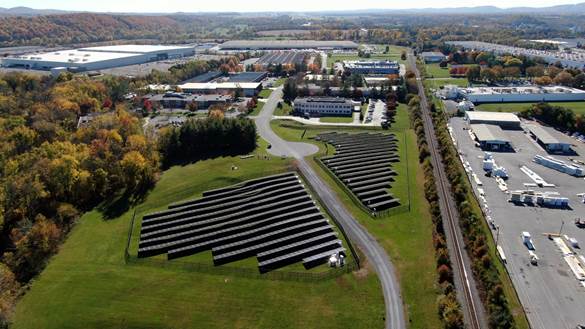It plans to install a micro-grid at the Prospect Center on Himes Ave.

Solar array at Ballenger-McKinney WWTP (Photo from Frederick County Government)
Frederick, Md (KM) Frederick County Government continues to lead the way in using renewable energy to power its buildings. That’s according to County Executive Jan Gardner who discussed that during her public information briefing last Thursday.
She said the solar canopy at the Bourne Building on Montevue Lane is expected to go on line soon. “Each canopy contains 84 solar panels for a total of 168 panels. There’s enough room underneath them to park 16 cars. And those canopies are nearly complete. We’re still awaiting delivery of one component before the panels go on line,” she says.
During the construction of the canopy, four electric vehicle charging stations were installed on site.
The Bourne Building houses the Division of Public Works and the Division of Parks and Recreation.
Gardner also said a solar array on a five-acre site near the Ballenger-McKinney Waste Water Treatment Plant off of Route 85 or Buckeystown Pike began operations early this year. “Waste water treatment plants are some of the largest energy users for any jurisdiction, and that is certainly true for Frederick County,” she says. “So we expect to save $130,000 a year in electric costs by generating this solar power.”
The array contains 3,528 solar panels and will generate approximately 1.8-million kilowatt hours a year, which is equal to about 17% of the treatment plant’s power usage, according to the County. It will also energize a backup power supply.
The County says it received a two state grants to offset the costs of these two project. The Maryland Energy Administration provided $43,000 for the solar canopy and EV charging stations. The Maryland Department of the Environment provided $2.3-million for the array powering the Ballenger-McKinney Waste Water Treatment Plant.
During her briefing, County Executive Gardner announced that 100% of the electricity used to power county government buildings comes from renewable sources. “We reached this milestone for fiscal year ’22 by taking two steps: generating more solar power, and buying wind power,”: she said.
There are other plans for using more solar energy in the future. “We are working with the American Microgrid Solutions to see if a micro-grid can be installed at the Prospect Center, our large building on Himes Avenue. And we’re transitioning our fleet to hybrid electric vehicles over time as that makes sense to do,” says Gardner.
By Kevin McManus
By Kevin McManus